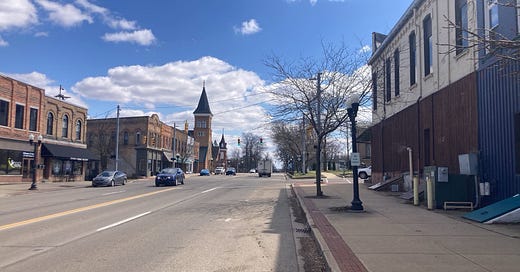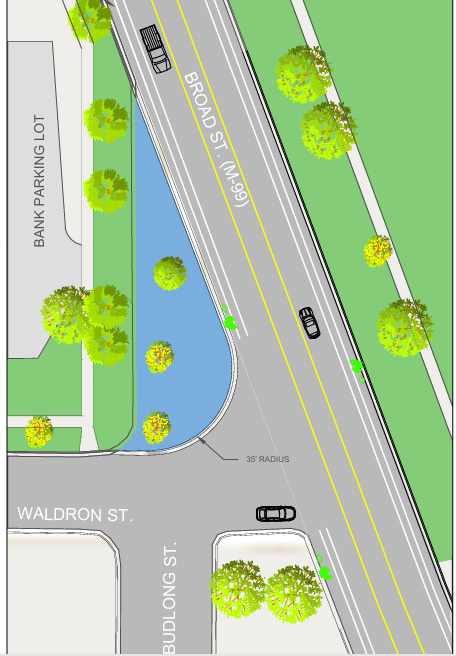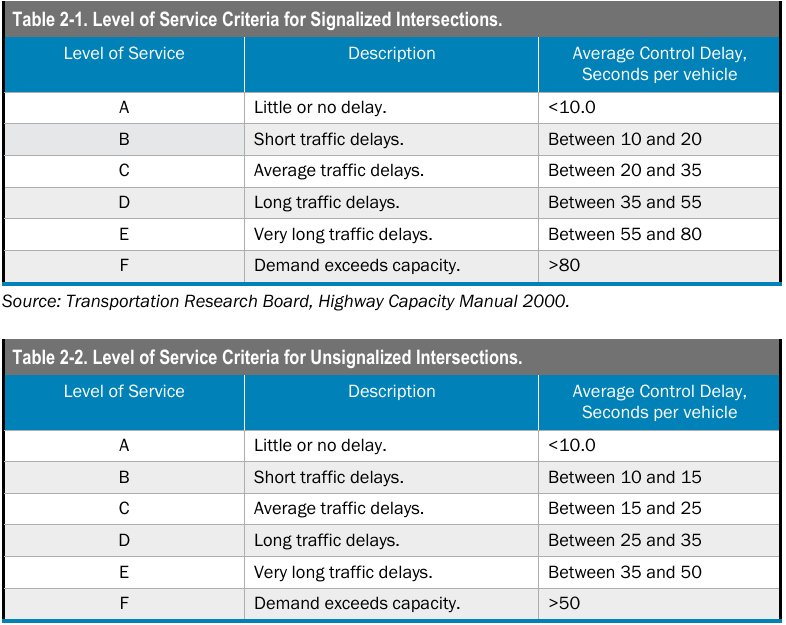Broad St. Road Diet Projected to Slow Traffic, Reduce Accidents, Increase Parking
City council will discuss the matter further upon the reception of an MDOT grant
City of Hillsdale—The proposed Broad Street traffic calming plan would increase traffic delays at a few key intersections, reduce overall accidents, expand downtown parking, and streamline complex intersections.
These projections come from Wade Trim, a civil engineering firm in Taylor, Michigan. The company provided estimates for traffic delays in the year 2030 with and without the implementation of the traffic calming plan.
Projected Traffic Flows in 2030: Broad, Bacon, & Cook
Without any changes, all of the M-99 intersections in 2030 would have a Level of Service rated as A, B, or C, meaning drivers will experience little or no delay, short traffic delays, or average traffic delays, respectively.
Drivers would experience the longest average delays at the intersection of Broad Street, Bacon Street, and Cook Street. This intersection received a B rating, with an average delay of 12.9 seconds in the peak morning hour (7:30 a.m. to 8:30 a.m.) and 12.7 seconds in the peak afternoon hour (3 p.m. to 4 p.m.).
If the city council adopts the road diet and reduces M-99 to three lanes, then the average delay at the Broad-Bacon-Cook intersection would increase slightly to 14 seconds in the peak morning hours and 14 seconds in the peak afternoon hours—an average increase of slightly more than 1 second.
Projected Traffic Flows in 2030: W. Carleton, E. Carleton, and Broad
Without the traffic calming plan, drivers would experience the second-longest delay at the intersection of West Carleton Road, East Carleton Road, and North Broad Street. This intersection received a B rating, with an average delay of 11.9 seconds in the peak morning hour and 12.7 seconds in the peak afternoon hour.
The road diet, if implemented, would cause the most significant delays at the Carleton-Carleton-Broad intersection. The average delay would jump to 25 seconds in the morning and 16 seconds in the afternoon.
Northbound traffic at the three-way intersection would fall from a B rating to a D rating as the delay would increase from 13.4 seconds to 42.7 seconds.
The delay for eastbound traffic would double, from 11.2 seconds to 22.5 seconds, but the delay for westbound traffic would fall from 11.5 seconds to 5.8 seconds.
Accidents along M-99
The traffic calming study projects a marginal decrease in the number of accidents along M-99.
Over three years, 2021 to 2023, there were 61 accidents, or 20.3 accidents per year. Of these, 17 accidents caused property damage and 3.3 caused injuries or fatalities.1
The study found that the traffic calming project would reduce total crashes to 18.49 per year, with 2.72 causing injuries and 15.77 causing property damage only.
“This would be an expected reduction of 1.81 crashes per year with the road diet compared to existing conditions,” according to the study.2
Downtown Parking
Besides reducing the number of lanes on M-99 from 4 to 3, the traffic calming project would also include structural changes to downtown streets and parking lots.
The post office parking lot, which is currently squeezed in between North Street, E. Carleton Road, Ferris Street, and Union Street, would significantly expand. Under the current plan, the city would eliminate the segment of Union Street between Carleton and North.
The number of parking spaces would increase from 11 to 47.
Reducing Intersections
The traffic calming plan would close three access points:
The one-way entrance onto N. Howell from Broad—the wedge between the City Hall and the post office (as seen in the picture above). This section of N. Howell would remain a one-way street, but the only entrance would be on E. Carleton, and the traffic would flow southbound into the expanded post office parking lot.
The one-way entrance onto Cook from Broad. If the road diet is adopted, the city council might vacate Cook and turn it into a parking lot for the adjacent property owners. The city council has also discussed plans to create an outlet from Cook onto Bacon to reduce congestion behind St. Peter’s and St. Anthony.
The section of Budlong between Waldron and Broad. This road would become a grassy area, and there would only be one way onto Waldron and Budlong from Broad.
Joshua Paladino
You can follow the Hillsdalian on Facebook and Twitter.
Related Articles:
Hillsdale City Council to Review Road Diet Plans
City of Hillsdale Road Diet Discussions Delayed Until Next Month
Appendix:
I haven’t found any evidence of a fatal crash on M-99 between Carleton and Steamburg during this period.
Another statistic has been referenced during discussions of the road diet. The study also states that road diets might bring “an overall crash reduction of 19 to 47 percent in expected number of crashes,” but this seemingly refers to a general study of road diets, not a particular study of the conditions in downtown Hillsdale.











I know fair week is only once a year, but I can't imagine what a mess this plan would make of that area for the week.